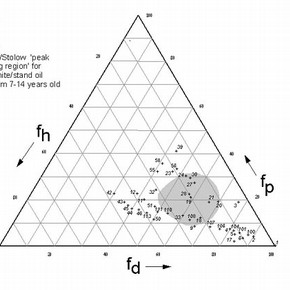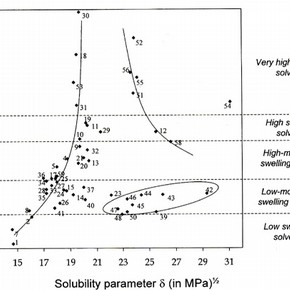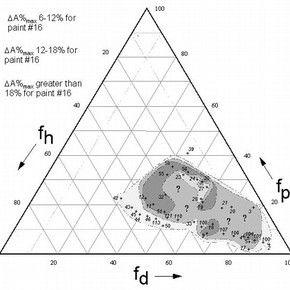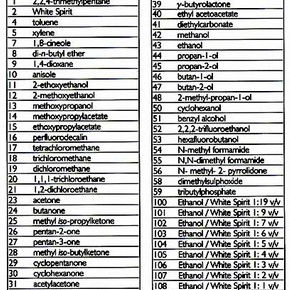Conservation Journal
Spring 2002 Issue 40
Building models: Comparative swelling powers of organic solvents on oil paint and the cleaning of paintings
Introduction
Non-original varnishes on paintings are often spirit varnishes, made from a natural resin, such as dammar or mastic, dissolved in a solvent like spirit of turpentine. However, these natural resins are intrinsically unstable and undergo chemical alterations over time (photo oxidation and other secondary reactions) that change their solubility, usually necessitating a more active, polar solvent to effect dissolution. The solvent required to remove an aged, oxidised varnish may not be wholly inactive on the original paint beneath, and much of the technical skill in cleaning lies in finding a solvent capable of removing varnish controllably with minimal effect on the original paint. It is inevitable in varnish removal that the solvent reaches the paint, since varnish does not provide an effective barrier to solvent penetration. It is therefore important to consider the potential effects of solvent on the paint, in order to assess the risks involved in solvent-cleaning.
Two main risks of solvent-cleaning have been identified, both relating to the effects of solvent on the organic binder phase of the paint - the dried oil and any additives. The risk more extensively studied is leaching, the possible extraction of low-molecular weight components of the paint binder by the action of the solvent. The more acute element of risk in cleaning, however, is that of swelling of the paint through sorption of solvent. The three-dimensional polymerised dried oil network may not be truly soluble, but the polymer network may swell by sorption of solvent molecules, ultimately forming a gel. Depending on the degree of swelling, the paint will be more or less softened and its capacity to bind the pigment particles may be affected. In the swollen condition, there is a risk that pigment may be removed from the paint through the mechanical action of the swab.
Swelling is a phenomenon that is tangible to the conservator and can be tested for prior to the commencement of cleaning. The magnitude of swelling caused by a given solvent is an indication of the strength of interaction between the solvent and the paint. It is known that solvents vary dramatically in their power to cause swelling of artists' oil paints. There is, however, limited data on oil paint swelling in solvents. The literature is confined to just three studies over the past 50 years, and only one of these, the comprehensive work of Stolow 1 in 1957, relates directly to artists' oil paints and to cleaning pictures. The extant data on oil paint swelling warranted re-examination, and that has been the goal of my recent research.
Describing solvent power: solubility parameters

Figure 1. Teas solubility diagram showing Hedley’s ‘peak swelling region’ (shaded area) based on Stolow’s data for lead white/stand oil paints, 7-14 years old. Numbers on the Teas chart define the positions of individual solvents and solvent mixtures used in the present study. See Table 1 for key. (click image for larger version)
Solvents located in the same region are expected to have similar properties and to be miscible/mutually soluble. The solubility of specific resins or the swelling of oil films can be represented as zones on the chart embracing all those solvents capable of dissolving or swelling the material concerned. It is important to identify the area of greatest sensitivity of the paint: the region on the chart which corresponds to those solvents that cause high levels of swelling to oil paint and, correspondingly, to potentially greater risk. If a varnish can be removed using a solvent that lies well away from the zone of high paint swelling, then the likelihood is that there will be a greater margin of safety in the cleaning process.
The use of the Teas chart model is largely based on the interpretation of Hedley more than twenty years ago. Using some of Stolow's data, Hedley 2 defined the parts of the Teas chart that corresponded to high levels of swelling, the so-called peak swelling region (see figure 1). Hedley's treatment clarified a number of important issues relating to solvent-cleaning; for example, that a binary mixture of solvents (e.g. ethanol or acetone mixed with White Spirits) may have a greater swelling effect than either of the two individual solvents used alone.
Developing the model: re-evaluating the Hedley/Stolow peak swelling region
The limitations of model systems often become apparent through use over time and they usually undergo a process of evolution in the direction of greater reliability and correspondence with reality. The Teas chart model of varnish removal is no exception. Its shortcomings derive partly from the constraints of the Teas fractional solubility parameter system and partly from the nature of the swelling data that feeds into the model. More specifically, the Stolow-derived data that Hedley used for defining the peak swelling region has been questioned regarding the extent to which it properly reflects the sensitivity of real artists' oil paints to solvent. This data set was for paint films composed of lead white pigment bound with linseed stand oil, but there are reasons to expect that stand oil paint films might behave differently with solvents than more conventional linseed oil paint media. It seemed appropriate, therefore, to develop the model by re-examining the swelling caused to typical artists' oil paints by sorption of organic solvents.
New swelling data

Figure 2. Compilation of swelling data for paint type #16 (Lead white and yellow ochre pigment in linseed oil, prepared in 1991, 140µm thick). Maximum swelling as a function of solvent solubility parameter ∂. (click image for larger version)
The findings 4 , 5 have confirmed Stolow's observation that the ultimate swelling power of solvents on oil paints varies in relation to a number of factors, of which solvent polarity or specific cohesiveness is especially important. On the basis of their swelling powers, the various solvents have been classified into five groups (figure 2). However, the relationship between swelling power and solubility parameter ∂ was found to be more complex than indicated by Stolow's earlier data for stand oil paints. Most notable differences are among the polar solvents (high values of ∂).

Figure 3. Teas solubility diagram showing sweling regions for paint type # 16 (click image for larger version)
Future directions
The need for further data to fill in some of the gaps in the Teas chart model of paint swelling is just one area for further work. There are several other issues coming out of this work that warrant further investigation. An assumption has been made that the degree of swelling caused by a solvent correlates directly with the vulnerability of the paint to mechanical abrasion: it remains to be demonstrated that this is indeed true. It might be expected that the physical swelling of severely aged oil paints is very much reduced compared to young paints, due to differences in internal chemistry and lower organic binder content.Dimension changes in very old paints may be so small as to approach the limits of reliable detection, yet there may still be changes to the physical properties of the paint that are significant for pigment binding. Furthermore, since both oxidative and hydrolytic degradation processes in oil paints lead to the formation of polar, hydrophilic species, the influence of water and aqueous environments on oil paint swelling is also a matter of considerable interest.
Returning to the Teas chart model of solvent cleaning, the recent results have added significantly to the corpus of data on oil paint swelling. It might now be appropriate to shift attention back to the varnish element. While much is known of the chemistry of varnish resin ageing, we still lack important knowledge on the specific solubility behaviour of resins: a more complete picture of how the solubility regions of resins like dammar and mastic change over time would certainly be useful.
It is hoped that at least some of these issues will be addressed in future research.
References
1. Stolow, N., The action of solvents on drying oil films, Parts I & II, Journal of the Oil and Colour Chemists Association, 40, 1957, pp377-402, pp488-499.
2. Hedley, G., Solubility parameters and varnish removal: a survey, The Conservator, 4, 1980, pp12-18. [Re-printed, with corrections, in Villers, C. (ed), Measured Opinions, United Kingdom Institute for Conservation. 1993, London, pp128-134.
3. Phenix, A., The swelling of artists' paints in organic solvents. Part 1 - a simple method for measuring the in-plane swelling of unsupported paint films, J. American Inst. for Conservation 41, 2002, pp43-60.
4. Phenix, A. The swelling of artists' paints in organic solvents. Part 2 - comparative swelling powers of selected organic solvents and solvent mixtures, J. American Inst. for Conservation, 41, 2002, p61-90.
5. Willmore, J., An examination of the solvent- induced swelling of leached oil paint. 3rd year Diploma project report, Dept. of Conservation & Technology, Courtauld Institute of Art, Univ. of London, 2000.
Note: Alan Phenix is currently Associate Professor at the Institute for Archaeology, Art History and Conservation, University of Oslo.
Spring 2002 Issue 40
- Editorial
- Sustainability and precaution - Part 1
- People watching: Monitoring heritage hospitality functions in historic houses
- Ethical considerations in the treatment of a Tibetan sculpture
- Building models: Comparative swelling powers of organic solvents on oil paint and the cleaning of paintings
- Further applications of Raman microscopy in paper conservation
- Critical evaluation of laser cleaning of parchment documents
- Collaboration
- Printer friendly version
